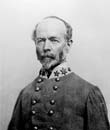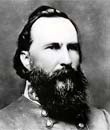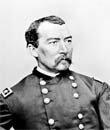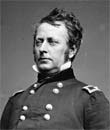
Day-by-Day Timeline of Events
April 12, 1861
With the refusal by Union forces at Fort Sumter to surrender their post, Confederate forces begin their ranged bombardment of the island.
April 12, 1861
At 4:30AM, a gun from Fort Johnson fires a star shell that detonates above Fort Sumter. This is the signal for the surrounding gun batteries to begin shelling the Union-held fort.
April 12, 1861
At 7:00AM, the guns of Fort Sumter return fire against Confederate positions in Charleston Harbor.
June 17, 1861
Captain Lyon leads his victorious Union forces against opposing militia at Boonville, Missouri in what becomes the Battle of Boonville. Losses are light for both sides and helps the Union maintain control of the Missouri River.
August 10, 1861

November 7, 1861
The Battle of Belmont is fought on Missouri soil. It marks the first major engagement for Union General Ulysses S. Grant. A force of about 5,000 Confederates square off against 3,114 Union in Mississippi County, Missouri. It is a Confederate victory but gives Grant much-needed experience in field command.
November 7, 1861
Confederate forces, including generals Leonidas Poke and Gideon Pillow, are victorious against a Union force under the command of General Grant at Belmont, Missouri.
December 28, 1861
The Battle of Sacramento is fought in Sacramento, Kentucky. 500 Confederates square off against 200 to 300 Union troops. The battle ends as a Confederate victory.
February 20, 1862
The Battle of Valverde begins pitting 3,000 union troops against 2,590 confederates in New Mexico Territory. Confederate General Henry Hopkins Sibley leads with General Thomas Green against Edward Canby. They are supported by Texas cavalry as well as land militia forces.
February 28, 1862
The Battle of Island Number Ten (New Madrid, Missouri) begins. Union forces are led by John Pope and Andrew Footer against Confederate foes headed by John McCown and William Mackall. Six Union gunboats are aided by eleven mortar rafts, facing a Confederate force of 7,000.
March 6, 1862

March 8, 1862
The Battle of Pea Ridge ends as a Union victory. 1,384 Union personnel are killed against 2,000 Confederate losses.
March 8, 1862
In the Battle of Hampton Roads, Virginia, CSS Virginia tangled with Union Navy forces n an effort to help unseat the Blockade.
March 9, 1862
At 7:00AM CSS Virginia departs Norfolk and heads to Hampton Roads to finish off USS Minnesota.
March 9, 1862
CSS Virginia is met by USS Monitor in what would come to be known as the "Battle of the Monitor and the Merrimack". Merrimack was the former name of CSS Virginia prior to her conversion as a Confederate ironclad.
March 9, 1862
Fighting between USS Monitor and CSS Virginia continues until 12:15PM at which point CSS Virginia withdraws. The battle, for all its importance to both sides, is labeled indecisive as little headway is made for either party. The Battle of Hampton Roads is over.
March 14, 1862
The Battle of New Bern is had in Craven County, North Carolina. 11,000 Union soldiers are supported by fourteen gunboats against a Confederate Army showcasing 4,000 troops and single cavalry regiment. The result is a Union victory with minimal losses on both sides.
March 23, 1862
The First Battle of Kernstown (Winchester, Virginia) is had. This one-day engagement sees a Union force numbering between 6,350 and 9,000 against a Confederate force of 3,000 to 4,200. Both sides gain the advantage as the Union claim a tactical victory and the Confederates a strategic one. Casualties number 590 for the North and 718 for the South.
March 26, 1862
The Battle of Glorieta Pass is fought between 1,300 Union troops and 1,100 Confederates. The engagement is a two-day affair spanning from March 26th until March 28th and leads to a Union Victory in northern New Mexico Territory.
April 4, 1862
Gneeral John Pope's Union forces at New Madrid, Missouri, complete the construction of a canal intended to bypass Confederate firepower along the Mississippi River at Island Number Ten.
April 6, 1862
The Battle of Shiloh begins in Hardin County, Tennessee. Union generals Ulysses S. Grant and Don Buell lead a force of some 63,000 against 40,335 Confederates led by generals Beauregard and Albert Johnston.
April 7, 1862
The Battle of Shiloh ends in a Union victory. 13,047 Union soldiers are killed along with 10,699 Confederate soldiers.
April 7, 1862
Island Number Ten along the Mississippi River, south of New Madrid, Missouri, is given up by the defending Confederate garrison.
April 8, 1862
The Battle of Island Number Ten draws to a close as the Union claims the victory. Some 7,000 Confederates surrender in the aftermath.
May 5, 1862
The Battle of Williamsburg occurs with inconclusive results for both sides. General McClellan leads Union forces against General Johnston and Longstreet. Casualties total 2,283 for the North and 1,682 for the South.
May 8, 1862
On this date the Battle of McDowell occurs - a one-day engagement pitting 6,500 Federals against 6,000 Confederates. Stonewall Jackson leads the latter and the battle goes down as a Confederate victory. Losses total 2,59 for the North and 420 for the South. Brigadier General Robert Milroy commanded the North.
May 23, 1862
On this date, General Jackson engages Union forces in the Battle of Front Royal. The engagement ends as a Confederate victory with 773 Union elements killed to just 36 Confederates. John Reese Kenly commanded the North garrison. The action now threatens supply lines to General Bank's forces.
June 1, 1862
The Battle of Seven Pines (Battle of Fair Oaks) ends as an inconclusive victory. Confederate General Joseph Johnston is badly wounded. Casualties amount to 6,134 Confederates against 5,031 Union fighters.
June 1, 1862

June 8, 1862
The Battle of Cross Keys is had pitting a Union force of 11,500 led by General Fremont against 5,800 Confederates under General Ewell. The result is a Confederate victory with 664 Union casualties versus 287 Confederates.
June 9, 1862
Union forces are driven back at Port Republic in Virginia during the one-day engagement known as the Battle of Port Republic. Union losses count 1,002 against the Confederate's 816.
June 27, 1862
The third contest of the Seven Days Battles is fought during the Battle of Gaine's Mill. It is a Confederate victory by Robert E. Lee over McLellan.
June 27, 1862
The fourth installment of the Seven Days Battles is fought during the Battle of Garnett's and Golding's Farm. It results as inconclusive and neither side fail to make headway. Losses are minimal by the war's standard - 189 Union elements to the Confederate's 438.
June 29, 1862
The Battle of Savage's Station, the fifth of the Seven Days Battles, is fought. It is another inconclusive engagement with the Union suffering 1,038 casualties against the Confederate's 473. Sumner led the Union forces against Magruder. Union forces withdraw.
June 30, 1862
The Battle of White Oak Swamp - as part of the Seven Days Battles - of fought and marks another inconclusive victory. Union General Franklin leads against Stonewall Jackson. Losses are minimal for both sides.
July 1, 1862
The Battle of Booneville is fought at Booneville, Mississippi. Losses are light for both sides with the Union claiming the victory.
July 5, 1862
The Battle of Lebanon takes place in Lebanon Kentucky. As many as 400 Union troops face off against 2,460 Confederates. The battle goes down as a Confederate victory.
August 5, 1862
Confederate General Henry Allen is wounded in the Battle of Baton Rouge, leading to his left leg being amputated. He will later be named governor of Confederate Louisiana.
August 5, 1862
The Battle of Baton Rouge takes place on this date. Forces include 2,500 Union against 2,600 Confederate. The battle goes down as a Union victory with similar losses to both sides (371 and 478 respectively).
August 8, 1862
Stonewall Jackson's forces cross the Rapidan River just north of Gordonsville to head off Union general Pope and his forces.
August 9, 1862
Nathaniel Banks' Union forces manage several victories before being driven back by Stonewall Jackson's forces.
August 11, 1862
General Jackson pulls his troops back across the Rapidan River for fear of arriving Union reinforcements.
August 13, 1862

August 18, 1862
Union General Pope is forced back over the Rappahannock River due to growing Confederate pressure.
August 27, 1862
Ewell's division is ordered to Bristoe Station by Stonewall Jackson to delay Pope's arriving troops.
August 28, 1862
The Second Battle of Bull run is had over a two-day period, beginning on August 28th and ending on the 30th. Confederate forces are under the command of Robert E. Lee with Union troops directed by John Pope. The battle results in a Confederate victory.
August 28, 1862
The Second Battle of Bull Run officially begins. Confederate shelling is heard at 6:30PM. The action takes place around Brawner's Farm (Groveton).
August 29, 1862
Stonewall Jackson's forces hold Stony Ridge. First contact between the two sides on this day is had at 7AM.
August 30, 1862
General Longstreet's force, under Major General Richard Anderson and having arrived on the battlefield at 3AM, enacts a counterattack that ultimately pushes Union elements to retreat.
August 30, 1862
The Second Battle of Bull Run ends as a considerable Confederate victory (as did the first). The Confederate forces were outnumbered man-to-man but managed significant casualties against the enemy.
September 1, 1862
The Battle of Chantilly (Virginia) - also known as "Ox Hill" - takes place. It ends inconclusively as both sides fail to gain the initiative. Casualties number 1,300 Union and 800 Confederate. The battle marks the end of the Northern Virginia Campaign that includes Second Bull Run.
September 4, 1862
Near Leesburg, Virginia, the Army of Northern Virginia begins its crossing along the Potomac River.
September 7, 1862
General George McClellan begins a slow advance away from Washington, D.C. to meet the Confederate threat emerging from Virginia.
September 9, 1862
Special Orders 191 is given by General Lee, ordering a special column formation to be taken by his troops to increase the chances of overtaking Harpers Ferry and the Union forces garrisoned there.
September 11, 1862
General Lee assigns General Longstreet to guard the approaches from the north while General Hill is given the task of the defending the approaches from the south of Harpers Ferry.
September 11, 1862
General Jackson engages Union forces at Martinsburg and drives them back towards Harpers Ferry.
September 12, 1862
The Battle of Harpers Ferry begins. Generals Miles and White lead a Union force of 14,000 against some 26,000 Confederate attackers under the command of generals Stonewall Jackson and A.P. Hill.
September 13, 1862
The Army of the Potomac arrives at Frederick, Maryland. Once there, soldiers recover a copy of General Lee's plans.
September 14, 1862
The Battle of South Mountain takes place. It is a Union victory for General McClellan, General Burnside and General Franklin over General Lee and General Hill.
September 14, 1862
The Battle of Crampton's Gap (Burkittsville) is a Union victory for General Franklin over General Cobb. Forces number 12,800 to 2,100, respectively.
September 14, 1862
The Battle of South Mountain is had in Maryland leading to a Union victory. 28,000 Union troops square off against 18,000 Confederates. Losses for both sides are nearly equal.
September 15, 1862
General Jackson's forces open up with artillery strikes against Union forces at Harpers Ferry.
September 15, 1862
A Confederate division under the command of General John Walker takes Loudoun Heights.
September 16, 1862
Having suffered a mortal wound at the Battle of Harpers Ferry, General Dixon Miles dies.
September 17, 1862
The Battle of Antietam is had near Sharpsburg, Maryland and results of the one-day engagement are tactically inconclusive. 87,164 Union troops (led by McClellan) face off against 38,000 Confederates (led by Lee). Casualties are 12,410 and 10,316 respectively.
October 8, 1862
The Battle of Perryville is had in Boyle Country, Kentucky. It pits 22,000 Union against 16,000 Confederates and results in a Union strategic victory. Losses are 4,241 and 3,396 respectively.
November 29, 1862
Following Union General Philip Kearny's death at the Battle of Chantilly in September of 1862, the Kearny Medal for Officers is established.
December 11, 1862
The Battle of Fredericksburg begins encompassing actions in Spotsylvania and Fredericksburg counties. The clashes pit a much smaller Confederate force of 78,513 against 122,009 Union troops. Commanders are General Lee (Confederate) against General Burnside (Union).
December 13, 1862
General Burnside's larger force is beaten by General Lee's Army of Northern Virginia as part of the Battle of Fredericksburg.
December 15, 1862
The Battle of Fredericksburg ends as a Confederate victory. Confederate numbers are 78,513 committed to action with losses numbering 4,201. Union numbers are 122,009 committed with 12,653 losses.
December 26, 1862
Union forces are beaten back at Chickasaw Bayou in Vicksburg, Mississippi. This two-day engagement marks the Battle of Chickasaw Bayou. Again, a much smaller Confederate force bests a larger Union army. The battle spans into December 29th.
December 31, 1862
The Battle of Stones River begins. Union General Rosecrans leads a force of 43,400 against 35,000 Confederates under General Bragg at Murfressboro, Tennessee. The battle is also known as the Second Battle of Murfreesboro.
January 2, 1863
The Battle of Stones River, also known as the Second Battle of Murfreesboro, comes to an end. It is a much-needed Union victory. Losses total 12,906 for the Union and 11,739 for the Confederates.
January 21, 1863
Union General Fitz John Porter is dishonorably discharged from the Union ranks for his conduct in the Second Battle of Bull Run.
April 30, 1863
The Battle of Chancellorsville begins in Spotsylvania County, Virginia. Union forces are directed by General Hooker while the Confederates are led by general's Lee and Jackson. The Confederates number a much smaller force at just over 60,000 men. They face Union strength (Army of the Potomac) of over 130,000.
May 6, 1863
The Battle of Chancellorsville is over as a Confederate victory. However, the Confederate Army is dealt a blow when it is revealed that Stonewall Jackson is mortally wounded (by friendly fire). Losses for both sides include 17,300 for the Union and 13,300 for the Confederates.
May 10, 1863
General "Stonewall" Jaskson dies of complications related to wounds suffered days earlier at the Battle of Chancellorsville. The event is a major blow to the Confederate military cause.
May 12, 1863
Union forces outside of Jackson, Mississippi are victorious at Raymond (Battle of Raymond). General James McPherson is the commander of the Army of the Tennessee and heads a force 12,000 strong against 4,400 Confederates (under John Gregg). Losses are 446 Union to 820 Confederates.
May 16, 1863
The Battle of Champion Hill (Baker's Creek) is a one-day engagement between the Army of the Tennessee under General Grant and the Department of Mississippi and East Louisiana. Force strength includes 32,000 and 22,000 respectively. Losses amount to 2,457 and 3,840 respectively. It is a Union victory.
June 7, 1863
The Battle of Milliken's Bend occurs. Confederate General Richard Taylor attacks a Union base at Madison Parrish, Louisiana. The attackers are driven off by a force led by commander Hermann Lieb. The result is a Union victory though casualties number 652 for the North.
July 1, 1863
In the northwest of Gettysburg, at Marsh Creek at about 5:30AM, the first shots of the Battle of Gettysburg are fired between Confederate and Union forces.
July 1, 1863
At 8:00AM, Confederate forces - as part of General Henry Heth's division - under the direction of General James J. Archer and General Joseph R. Davis march on Gettysburg.
July 1, 1863
At 10:00AM, during the fighting at Gettysburg, Union General John F. Reynolds is killed.
July 1, 1863
General Solomon Meredith's "Iron Brigade" repels General Archer's Confederates and captures Archer and a few hundred others.
July 1, 1863
At 2:00PM Major General Robert E. Rodes moved his troops against the Union right flank.
July 1, 1863
At 2:00PM, Union General Meade calls on General Winfield S. Hancock to succeed the slain General Reynolds.
July 1, 1863
Upon arriving on scene at about 2:30PM, General Robert E. Lee surveys the battlefield from Herr Ridge.
July 1, 1863
General Lee advances General Heth and William Dorsey Pender's forces. General Heth is wounded.
July 1, 1863
At 3:30PM General Schurz units retreat under attacks from General Jubal A. Early. Their retreat is through the town of Gettysburg itself.
July 1, 1863
At 4:00PM General Pender pushes Union forces to retreat into Gettysburg proper as well as into Cemetery Hill.
July 1, 1863
At 4:30PM, Union forces retreat from Gettysburg and take up fortified positions at the town's south, in Cemetery Hill.
July 1, 1863
At 4:30PM, General Lee provides General Ewell with the option to attack Union forces at Cemetery Hill if an advantage can be had and maintained. Lee understands the Federal forces hold positions on high ground. Ewell does not move on the enemy - perhaps missing a tremendous opportunity to turn the tide of the battle on its first day.
July 2, 1863
At 4:00PM, Federal positions are assailed by Confederate elements at Little Round Top and Devil's Den. Devil's Den falls to the attackers but the defenders at Little Round Top hold out.
July 2, 1863
At 5:30PM, Wheat Field and Peach Orchard, Union-held named areas to the Southwest of Gettysburg, are attacked by forces under the command of General Lafayette McLaws.
July 2, 1863
The ownership of Wheat Field is changed some four times before General Sickle's forces are pushed to the base of Little Round Top. The defensive stand there holds off the Confederates however.
July 2, 1863
Union forces continue to hold primary positions though the Confederates claim some terrain against them - particularly at Cemetery Hills and Culp's Hill.
July 3, 1863

July 3, 1863
From 5:30AM until 10AM, Confederate forces make repeated attempts to unseat and drive off Union forces at Culp's Hill. Little ground is gained in the fighting.
July 3, 1863
Union-held Seminary Ridge is attacked by forces under the command of General Pickett, General Pettigrew and General Trimble.
July 3, 1863
At 3:30PM, General Stannard leads his Union troops against the side of General Pickett's charging division.
July 3, 1863
By 3:45PM, Confederate forces have advanced as much as they will in the battle as Union lines hold.
July 3, 1863
General Farnsworth and his cavalry forces suffer considerable losses against the Confederate lines - the charge called by General Kilpatrick against General Longstreet's position southwest of Big Round Top.
July 3, 1863
At the age of 26, cavalry General Elon J. Farnsworth is killed at the Battle of Gettysburg after a cavalry charge led by General Kilpatrick. Farnsworth protested the action but obeyed nonetheless.
July 3, 1863
At the end of the battle to control Gettysburg (a decisive Union victory), over 57,000 persons became casualties, many wounded, with 23,055 belonging to the Union lines and as many as 28,000 suffered by the Confederacy. Wounded number over 25,000 combined. The Confederacy suffered mightily in terms of officer-level depletion.
September 20, 1863
Confederate forces, in one of the rare meetings where they outnumbered Union forces, claim the victory at the Battle of Chickamauga. Union elements collapse and are pushed away in the stunning defeat.
September 18, 1863
The Battle of Chickamauga begins pitting Northern forces led by General Rosecrans against Southern forces led by General Bragg. The North commits about 60,000 souls to the South's 65,000. The battle lasts two days and covers the counties of Catoosa and Walker in Georgia.
October 19, 1863
After the events of Chickamauga, Union General William Rosecrans is relieved of his command. He is succeeded by General George Thomas.
November 2, 1863
This date marks the start of the Battle of Brownsville (Texas). General Banks leads the Union against Mexican Patriots led by former Confederate Generals.
November 23, 1863
The Battles for Chattanooga take place from November 23rd to NOvember 25th. Orchard Knob, Lookout Mountain, Missionary Ridge, and Rossville Gap are some of the names associated with the actions. General Grant faces General Bragg and his Army of the Tennessee.
November 25, 1863
The Chattanooga Campaign comes to a close and is recorded as a Union victory, further enhancing General Grant's growing legacy in the war.
November 27, 1863
Union General Meade and his forces move to tackle the forces of General Less at Mine Run, Virginia. The Battle of Mine Run ensues and spans from November 27th until December 2nd. Union strength numbers 81,000 against a Confederate Army of 48,000.
December 2, 1863
Results of the Battle of Mine Run are inconclusive. Casualties amount to 1,272 Union losses and 680 Confederate.
February 20, 1864
The Battle of Olustee (Florida) is had. 5,500 Union troops face 5,000 Confederates. The battle is a Confederate victory with 1,861 Union wounded to the South's 946. Commanding officers are Truman Seymour (Union) and Joseph Finnegan (Confederate).
February 22, 1864
The Battle of Okolona takes place in Chickasaw County, Mississippi. Confederate forces, numbering 2,500 under the leadership of General Forrest, is victorious against a larger Union contingent of 7,000 under the direction of William Sooy Smith.
April 9, 1865
The Battle of Fort Blakely comes to a close. It is a Union victory for Army of West Mississippi commander Edward Canby.
May 5, 1864
The Battle of the Wilderness takes place across Spotsylvania and Orange counties in Virginia. Generals Ulysses Grant and George Meade face-off against Robert E. Lee. Strength includes 124,232 for the Union and about 65,000 for the Confederacy.
May 6, 1864
Confederate General Micah Jenkins is killed by friendly fire during the Battle of the Wilderness.
May 6, 1864
Confederate General James Longstreet is seriously wounded at the Battle of the Wilderness by friendly fire.
May 7, 1864
The Battle of the Wilderness comes to an end as an inconclusive engagement. Losses and casualties for the Union number 17,666 and the Confederate totals 11,033.
May 7, 1864

May 8, 1864
The Battle of Spotsylvania Court House begins. Union Generals Grant and Meade square off, once again, against Confederate General Robert E. Lee. The action takes place in Spotsylvania County, Virginia. Union forces number as many as 110,000 against a Confederate army of 63,000.
May 9, 1864
The Battle of Cloyd's Mountain is a limited engagement between 6,100 Union troops against 2,400 Confederates. It takes place in Pulaski County, Virginia and goes down as a Union victory. The battle is significant in eliminating the last Confederate line from Virginia into Tennessee. General George Crook directs the victors against Confederate Generla Albert Jenkins. Losses are 688 to 538, respectively.
May 11, 1864
The Battle of Yellow Tavern is had in Hanover County, Virginia. It is a Union victory for General Sheridan and a loss for the combined forces of Confederate Generals Jeb Stuart and Fitzhugh Lee. Numbers are 12,000 for the victors and 5,000 for the defeated. Casualties number 625 and 300 respectively.
May 12, 1864
The Battle of Meadow Bridge takes place and is a Union victory as part of the Overland Campaign. General Sheridan is victorious over generals Fitzhugh Lee and James Gordon.
May 12, 1864
Confederate General J.E.B. Stuart, aged 31, dies of wounds suffered at the Battle of Yellow Tavern the day before.
May 15, 1864
The Battle of Fort Darling - or Battle of Drewry's Bluff - is had pitting five Union warships against an artillery-laden Confederate fort in Chesterfield County, Virginia. It is a Confederate victory for General Beauregard. Union General Benjamin Butler is handed the defeat.
May 15, 1864
Confederate General Johnston withdraws his forces near Dalton, Georgia, under growing pressure from General Sherman.
May 15, 1864
The Battle of New Market takes place in Shenandoah County, Virginia. It is a Confederate victory for General Breckinridge over General Franz Sigel. Forces number 4,087 to 6,275, respectively, and losses total 531 to 841, respectively.
May 18, 1864
The Battle of Yellow Bayou is had in Avoyelles Parish, Louisiana. It results in a Union victory though not without both sides gaining, and eventually losing, the advantage several times during the battle. The Union is directed by Joseph Mower and the Confederates by Richard Taylor. Losses are 360 and 500 respectively.
May 20, 1864
The Battle of Spotsylvania Court House concludes as a Confederate tactical victory. General Lee takes the credit over Union leaders General Grant and Meade. Casualties and losses number 12,687 for the victors and 18,399 for the defeated.
May 20, 1864
The Battle of Ware Bottom Church sees Confederate General Beauregard victorious over Union General Benjamin Butler. The fighting takes place in Chesterfield County, Virginia.
May 21, 1864
Confederate General Albert Jenkins dies of his wounds suffered at the Battle of Cloyd's Mountain, Virginia. He was 33.
May 23, 1864
The Battle of North Anna begins spanning Caroline and Hanover counties in Virginia. Union forces are led by Ulysses Grant and George Meade against Robert E. Lee and the outnumbered Confederate army (Army of Northern Virginia).
May 24, 1864
The Battle of Wilson's Wharf is fought. It is a Union victory at Charles City, Virginia. General Edward Wild claims the victory over General Fitzhugh Lee.
May 26, 1864
The Battle of North Anna ends with inconclusive results as neither side gains the advantage.
May 26, 1864
The Battle of New Hope Church in Georgia sees the Military Division of the Mississippi, under the leadership of Generals Sherman and Hooker, lose to the Army of Tennessee led by General Johnston.
May 30, 1864
The Battle of Old Church takes place. It is a Union victory for General Alfred Torbert.
May 31, 1864
The Battle of Cold Harbor begins as part of the Overland Campaign. Union forces number over 100,000 and are led by generals Ulysses S. Grant and George Meade. They face a Confederate army numbering around 60,000 and are led by General Robert E. Lee.
June 10, 1864
The Battle of Brice's Crossroads is recorded. A smaller Confederate force of 3,500 cavalry is victorious against a Union army consisting of 4,800 troops, 3,300 cavalry, and 22 field guns. General Nathan Forrest directs the victors over General Samuel Sturgis of the Union. The action takes place near Guntown, Mississippi.
June 11, 1864
The Second Battle of Cynthiana is had in Kentucky. The Union victory emerges from a two-day contest in which 3,450 Union face-off against 1,200 Confederates. Losses equal 1,092 and 1,000 respectively.
June 11, 1864
The Battle of Trevalian Station is had in Louisa County, Virginia. Confederate Generals Wade Hampton and Fitzhugh Lee are victorious over Union leader General Sheridan. The battle spans into the 12th. Strength is 6,762 Confederates versus 9,286 Union. Casualties are 813 to 1,512 respectively.
June 12, 1864
The Battle of Cold Harbor ends as a much-needed Confederate victory for General Robert E. Lee. Frontal assaults against fortified Confederate positions mar the Union advance which leads to thousands of casualties.
June 17, 1864
The Battle of Lynchburg is fought over a two-day span by two small forces. The Confederates numbering 14,000 under General Jubal Early are victorious in beating back 16,643 Union attackers led by General David Hunter.
June 24, 1864
The Battle of Saint Mary's Church takes place as part of the Overland Campaign. It is inconclusive.
June 27, 1864
The Battle of Kennesaw Mountin results in a Confederate victory. General Joseph Johnston faces off against Union General William Sherman in the clash. Numbers are 17,733 to 16,225 respectively and losses include 1,000 to 3,000, respectively.
July 9, 1864
The Battle of Monocacy in Frederick County, Maryland, sees a Union force (commanded by Lew Wallace) of 5,800 strong go up against a much larger Confederate army of 14,000. The successful delay of General Jubal Early's troops, en route to Washington, D.C., makes it a Union strategic victory. Washington, D.C. is reinforced in the mean time.
July 11, 1864
Fort Stevens in Washington, D.C. is fired upon by elements of Confederate General General Early (the Battle of Fort Stevens). This occurs during a visit by President Lincoln.
July 17, 1864
The Battle of Cool Spring takes place over two days between a Union force of 5,000 against a Confederate army of 8,000. It results in a Confederate victory for General Jubal Early and John Breckinridge.
July 20, 1864
The Battle of Rutherford's Farm takes place (also known as Carter's Farm and Stephenson's Depot). It is a Union victory for General Averell over General Ramseur. Forces number 2,350 Union against 3,300 Confederates.
July 20, 1864
The Battle of Peachtree Creek takes place in Fulton County, Georgia. 21,655 Union troops under George H. Thomas claim the victory over the 20,250 Confederate army led by General John Hood (Army of Tennessee). Losses are 1,900 to 2,500, respectively.
July 22, 1864
The Battle of Atlanta becomes a Union victory. 34,863 Union troops under Generals Sherman and McPherson face-off against the Army of Tennessee and its 40,438 troops led by General Hood and Hardee. Losses are 3,641 against 5,500, respectively.
July 24, 1864
Kernstown, Virginia is the site of a successful cavalry attack by General Jubal Early over Union forces. It is recorded as the Second Battle of Kernstown.
August 1, 1864
The Battle of Folck's Mill takes place. It is an inconclusive engagement. Also known as the Battle of Cumberland.
August 2, 1864
The Battle of Mobile Bay begins pitting a Union force of 12 wooden ships, 4 ironclads and 2 gunboats against a Confederate force of 3 gunboats and one ironclad. Additionally, 5,500 Union troops make up a land contingent while the Confederates field 1,500 men. The battle would last until August 23rd. David Farragut and Gordon Granger are the Union leaders. The Confederates are led by Franklin Buchanan and Richard Page.
August 7, 1864
The Battle of Moorefield takes place in Hardy County, West Virginia. It is a Union victory for General William Averell over Confederate leader John McCausland. Union strength is 1,760 against 3,000 Confederates. Casualties are 42 against 488, respectively.
August 8, 1864
The Union Army, directed by Gordon Granger, takes Fort Gaines (Dauphin Island) during the Battle of Mobile Bay. 900 prisoners are taken.
August 16, 1864
The Battle of Guard Hill in Warren County, Virginia is an inconclusive engagement between the two parties. General Thomas Devin leads Union forces against Confederate General William Wofford. Losses are 71 to 480, respectively. The engagement is also known as the Battle of Crooked Run.
August 21, 1864
The Battle of Summit Point, also known under the names of Flowing Springs and Cameron's Depot, takes place in Summit Point, West Virginia. It is an inconclusive engagement involving Union General Sheridan and Confederate Generals Anderson and Early.
August 23, 1864
The Battle of Mobile Bay comes to a close on this date. It is a Union victory with 151 killed and 177 wounded for the Union and 13 killed and 22 wounded for the Confederate. One Union ironclad is sunk. 1,587 Confederate troops are captured in the fighting and one gunboat destroyed.
August 23, 1864
Union General Gordon Granger claims Fort Morgan during the Battle of Mobile Bay. Confederate General Richard Page surrenders the fort.
August 25, 1864
The Battle of Smithfield Crossing is another inconclusive engagement between the two sides in West Virginia. The fighting spans August 25th into August 29th.
August 31, 1864
The Battle of Jonesborough begins in Clayton County, Georgia. General Sherman leads 70,000 Union troops against 24,000 Confederates under General Hood and General Hardee.
August 31, 1864
A repulsed attack at Jonesborough effectively marks the last attempt by the Confederacy to hold Atlanta.
September 3, 1864
From the period of September 3rd until the 4th, the Battle of Berryville takes place in Clarke County, Virginia. It is an inconclusive engagement.
September 19, 1864
The Third Battle of Winchester (Battle of Opequon) is had. It is a Union victory in Virginia for General Sheridan over General Early.
September 19, 1864
The Third Battle of Winchester is fought as a Union victory. General Sheridan leads Union forces against Confederate Jubal Early in Virginia.
September 21, 1864
The Battle of Fisher's Hill takes place in Shenandoah County, Virginia. It is a Union victory for General Sheridan over General Early. Fighting spans the 21st into the 22nd.
September 22, 1864
General Sheridan of the Union Army is victorious over Jubal Early and his Confederate force at the Battle of Fisher's Hill in Virginia.
September 29, 1864
The Battle of Chaffin's Farm and New Market Heights is had. Union forces, numbering 26,600 strong, are led by General Benjamin Butler. The Confederate force numbers 14,500 and is led by General Robert E. Lee and General Richard Ewell. The battle spans September 29th into the 30th in Henrico County, Virginia and ends as a Union victory.
October 2, 1864
The Battle of Saltville in Virginia takes place. The one-day battle is a victory for the Confederate Home Guard numbering 300. They face a force of 5,000.
October 5, 1864
The Battle of Allatoona is fought in Bartow County, Georgia. Union strength numbers 2,025 against a Confederate army of 3,276. The clash is a Union victory, part of the Franklin-Nashville Campaign, with casualties totaling 706 for the victors and 897 for the South.
October 9, 1864
The Battle of Tom's Brook takes place in Shenandoah County, Virginia. It is a Union victory.
October 19, 1864
The Shenandoah Valley is made more secure with a Union victory at the Battle of Cedar Creek in Virginia. General Sheridan is victorious over General Early in this one-day affair.
October 21, 1864
The Battle of Little Blue River is recorded as a Confederate victory. General Price leas his men over General Curtis with a force of 8,500 to 2,000, respectively. The fighting takes place in Jackson County, Missouri.
October 22, 1864
The Battle of Byram's Ford is fought. Union forces are victorious in Kansas City, Missouri.The battle rages into the 23rd.
November 22, 1864
The Battle of Griswoldville is fought in Jones County, Georgia. It is a Union victory.
November 24, 1864
The Battle of Columbia in Tennessee is had between a Confederate force of 35,000, led by General Hood, against a Union Army numbering 28,000 under General Schofield. The fighting lasts until the 29th.
November 29, 1864
The Battle of Spring Hill is fought in Maury County, Tennessee. Union General Schofield claims the victory over General Hood.
November 30, 1864
The Battle of Franklin takes place on this date. 27,000 Union troops face-off against 27,000 Confederates. The battle is recorded as a Union victory for General Schofield over General Hood. Losses include 2,326 for the victors and 6,252 for the Confederates. An ill-advised charge by Hood costs the Confederate army dearly as losses total 25% of his fighting force.
November 30, 1864
The Battle of Honey Hill is fought in Jasper County, South Carolina, and ends as a Confederate victory despite a force of 1,400 facing 5,000 Union troops.
December 1, 1864
Confederate forces under the command of General John Hood of the Army of Tennessee amass outside of Nashville. Numbers will soon reach 30,000 for the Battle of Nashville by mid-month.
December 15, 1864
The Battle of Nashville (Tennessee) begins with a Confederate force of 30,000 under General Hood facing General Thomas and his 55,000-strong Union army.
December 16, 1864
The Battle of Nashville ends as a Union victory for General George Thomas. Confederate General Hood's losses are double (6,000 to 3,061) what Union forces see. The end of the fighting also spells the end for the Army of Tennessee.
February 5, 1865
The Battle of Hatcher's Run begins in Dinwiddle County, Virginia. A 34,517 strong Union force faces a 13,835 strong Confederate army. Union forces are headed by General Andrew Hunmphreys and General Gouverneur Warren. Confederate forces are directed by John B. Gordon.
February 7, 1865
The Battle of Hatcher's Run in Virginia comes to a close. It is a Union victory. Losses total 1,539 for the Union and 1,161 for the Confederacy.
February 11, 1865
The Battle of Wilmington (North Carolina) begins between 12,000 Union and 6,000 Confederate troops. Generals Schofield and Porter lead the Union against General Bragg of the Confederacy. Fighting would last until February 22nd.
February 21, 1865
The Battle of Douglas Landing takes place in Pine Bluff, Arkansas. It is a Confederate victory.
March 2, 1865
The Battle of Waynesboro takes place in Virginia. It is a Union victory and notable for the destruction of General Jubal Early's army. Strength includes 2,500 Union against 1,600 Confederates with casualties being 9 to 1,500, respectively.
March 10, 1865
The Battle of Monroe's Crossroads is recorded on this date. Fighting takes place near Fayetteville in North Carolina and is an inconclusive engagement.
March 16, 1865
The Battle of Averasborough takes place in North Carolina. It is an inconclusive engagement between the forces of General Sherman and General Hardee.
March 19, 1865
The Battle of Bentonville takes place in Bentonville, North Carolina. It is a Union victory for General Sherman over General Johnston. Strength is 60,000 to 21,900 with losses reaching 1,527 to 2,606, respectively. Fighting goes into the 21st.
March 25, 1865
Union troops are victorious at the Battle of Fort Stedman in Petersburg, Virginia. The engagement is also known as the Battle of Hare's Hill.
April 1, 1865
The Battle of Five Forks is fought between forces of General Sheridan and General Pickett near Petersburg, Virginia. It is a Union victory with lopsided losses for the Confederacy (2,950 Confederates to 830 Union).
April 2, 1865
The Battle of Fort Blakely begins in Baldwin County, Alabama. It is part of the Mobile Campaign and pits 45,000 Union attackers against 4,000 Confederate defenders. This battle marks the last combined-force engagement of the Civil War.
April 2, 1865
The Battle of Selma takes place in Selma, Alabama. It is a Union victory for General James Wilson and a defeat for Confederate General Nathan Forrest. Strength is 9,000 to 4,000, respectively. Confederate forces suffer mightily as some 2,700 are taken prisoner (General Forrest manages to escape capture).
April 4, 1865
Union forces take Tuscaloosa, Alabama in the Battle of Tuscaloosa. It is captured by General John Croxton.
April 6, 1865
The Battle of Sailor's Creek (or Sayler's) takes place between Union General Philip Sheridan and his 26,000-strong army against Generals Richard Ewell and John Gordon of the Confederacy. Confederate strength numbers 18,500 men. It is a Union victory in Virginia.
April 9, 1865
The Battle of Appomattox Court House takes place marking one of the final engagements of the American Civil War. The battle is a decisive Union victory and sees General Lee surrender his Army of Northern Virginia to General Grant. The Union army is made up of 150,000 soldiers against the Confederate's 28,000.
April 16, 1865
The Battle of West Point takes place in West Point, Georgia. It is a Union victory for Oscar La Grange over Robert Tyler. This engagement marks the last battle to take place east of the Mississippi River.
May 12, 1865
The last battle of the Civil War is fought at Palmetto Ranch near Brownsville (Texas). The Battle of Palmetto Ranch spans two days.




